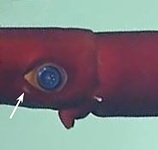Echinoteuthis
Richard E. Young- Echinoteuthis atlantica (Joubin, 1933) Joubin, 1933
- Echinoteuthis famelica (Berry, 1909) (Berry, 1909)
- Echinoteuthis glaukopis (Chun, 1908)
- Echinoteuthis tyroi (Salcedo-Vargas, 1997)
- Echinoteuthis danae (Joubin, 1933) (Joubin, 1933)
Introduction


Figure. E. atlantica, in situ photograph from an ROV of NOAA's R/V OKEANOS EXPLORER near the ocean floor at 866 m depth.
Only one species (E. famelica) in Echinoteuthis is well known. Each species, of those known from subadults, is thought to occupy a different ocean: E. glaukopis - Indian Ocean; E. famelica - Pacific Ocean; E. atlantica - Atlantic Ocean. Two species (E. tyroi - Indian Ocean, and E. danae - Atlantic Ocean) are known only from paralarvae and may belong to the known species from their area.

Fig. Same squid as above. Arrow points to apparent window in the squid's eyelid over its photophore.
Brief diagnosis:
Species of Echinoteuthis ...
- with large eyelid photophore.
- without other photophores.
- Presumably with tubercules in paralarvae.
Characteristics
- Arms
- Arms III distinctly longer than arms I.
- Arms III distinctly longer than arms I.
- Tentacles
- Little variation in sucker size over most of tentacular club.
- Club suckers large; reach a diameter of 0.3-0.4 mm in large squid.
- Head
- Funnel pocket present.
- Funnel pocket present.
- Funnel
- Funnel locking-apparatus ear shaped with large tragus and weak antitragus; posterior margin not undercut.
- Funnel locking-apparatus ear shaped with large tragus and weak antitragus; posterior margin not undercut.
- Fins
- Fins slightly longer than broad (except, apparently in E. glaukopis).
- Fins slightly longer than broad (except, apparently in E. glaukopis).
- Tubercules
- Tubercules absent from integument except in paralarvae.
- Tubercules absent from integument except in paralarvae.
- Photophores and pigmentation
- Large round to oval photophore located on the anteroventral margin of each eyelid.
- No ocular or integumental photophores.
- Most pigment in closely-spaced chromatophores.
Comments
E. glaukopis is known only from the holotype which is small (37 mm ML including tail) and has lost all trace of pigment. At present its geographical distribution is the only feature known to separate it from the other two species. E. atlantica is also poorly known, however, it has relatively large trabeculate protective membranes on the tentacular clubs which separates it from E. famelica. The presence of E. danae and E. tyroi as members of Echinoteuthis has not been clearly established.
About This Page

University of Hawaii, Honolulu, HI, USA
Correspondence regarding this page should be directed to Richard E. Young at
Page copyright © 2019
 Page: Tree of Life
Echinoteuthis .
Authored by
Richard E. Young.
The TEXT of this page is licensed under the
Creative Commons Attribution-NonCommercial License - Version 3.0. Note that images and other media
featured on this page are each governed by their own license, and they may or may not be available
for reuse. Click on an image or a media link to access the media data window, which provides the
relevant licensing information. For the general terms and conditions of ToL material reuse and
redistribution, please see the Tree of Life Copyright
Policies.
Page: Tree of Life
Echinoteuthis .
Authored by
Richard E. Young.
The TEXT of this page is licensed under the
Creative Commons Attribution-NonCommercial License - Version 3.0. Note that images and other media
featured on this page are each governed by their own license, and they may or may not be available
for reuse. Click on an image or a media link to access the media data window, which provides the
relevant licensing information. For the general terms and conditions of ToL material reuse and
redistribution, please see the Tree of Life Copyright
Policies.
- First online 19 November 2007
- Content changed 31 October 2018
Citing this page:
Young, Richard E. 2018. Echinoteuthis . Version 31 October 2018 (under construction). http://tolweb.org/Echinoteuthis/65305/2018.10.31 in The Tree of Life Web Project, http://tolweb.org/









 Go to quick links
Go to quick search
Go to navigation for this section of the ToL site
Go to detailed links for the ToL site
Go to quick links
Go to quick search
Go to navigation for this section of the ToL site
Go to detailed links for the ToL site